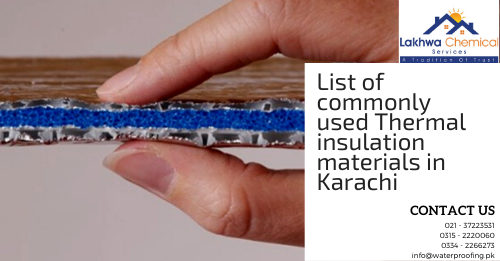List of commonly used Thermal insulation materials in Karachi
Thermal Insulation materials in Karachi
Heat proofing requires materials or at the very least chemical treatment around your roof or walls in order to get protected by excessive sunlight and temperature rising. To have a more sound defense from heat waves, there are that have gain momentum in heat proofing industry in recent years. So how do we characterize good thermal material from a bad one? It’s simply dependent on certain variables such as Price per square inch, R-factor, whether the thermal insulation materials is environmental or not and secondly whether the material is flammable or not. Based on all these variables, we can better understand the material internal property and its usage for your roof heat proofing solution in Karachi. Let’s learn the top 5 commonly used thermal insulation materials in Karachi for heat proofing.
1.Fiberglass
Cost per square inch: Low
R-value: 3.1
Environmental friendly: Yes
Flammable: no
Description:
Being one of the most affordable thermal insulation materials used in Karachi, fiberglass has been used extensively as heat proofing material for homes and commercial uses. The biggest reason for its success is its composition, which doesn’t absorb water, made out of silicon glass shards and has an R-Value (Resistance values in short) of around 2.9 – 3.8. The only drawback for using fiberglass regarding thermal element is the safety of labor during installation. It’s not safest material as it can damage your eyes, skin, and lungs. Wearing proper equipment is absolutely necessary for installing fiberglass for the first time, which not only restrict any accidents but also more suitable for more heat proofing customers in Karachi.
Read More
Top 6 thermal insulation material that keeps your home cool
Waterproofing membrane in Pakistan
Benefits of thermal insulation in Pakistan for Commercial Buildings
2.Mineral Wool
Cost per square inch: Moderate
R value: 3.1
Environmental friendly: Yes
Flammable: no
Description:
One of the recycled thermal insulation materials used in Karachi, which is made from many various different compounds such as glass, basalt or steel. As the name suggests, mineral wool is made from earth grown minerals which has the tendency to protect your roof from harsh environment regarding heat waves and hot weather. With its flexible usage and no compact structure, the Mineral wool has the R-value of 2.8 – 3.5 which is the most suitable for large areas, usually industries and commercial buildings.
3.Cellulose
Cost per square inch: Moderate
R-value: 3.7
Environmental friendly: Yes
Flammable: Yes
Description:
The most environmental thermal insulation materials in Karachi which is entirely made from recycled paper, cardboard boxes and newspaper, Cellulose is widely used as a heat insulation material in Pakistan. The biggest reason for its success lies inside the fire resistant tendency which cellulose pertains. Due to no oxygen element inside the compound, cellulose can resist fire and minimize the danger regarding such calamities. With low to moderate cost of the thermal insulation materials, its R-value ranges from 3.1 – 3.7, which is highly effective for homes and buildings.
Read More
Types of advanced insulation options used in Pakistan
Cost saving through outer wall heat proofing
Different types of internal wall insulation methods in Pakistan
4.Polyurethane Foam
Cost per square inch: High
R-value: 6.3
Environmental friendly: No
Flammable: Yes
Description:
Polyurethane foam works as a mighty thermal insulation materials in Karachi with a very high R-value of around 6.3. Using the non-chlorofluorocarbon (CBC) has a spraying agent, the polyurethane poss less danger for our environment as well as with proper strategy during blowing the compound into the rooftops or walls for heat proofing solution, It can prove to be quite beneficial, even if the surface has no insulation property whatsoever. This low-density foam can be applied quickly than other thermal insulation materials and can also be applied on any surface without much external assistance. Also, Polyurethane is fire resistant so which is another advantage of using this thermal material.
5.Polystyrene
Cost per square inch: Low
R-value: 4
Environmental friendly: No
Flammable: Yes
Description:
Polystyrene is considered to be one of the highly used waterproofing based thermal insulation material in Karachi usually formed with two types of material available in the market, expanded and extruded. Basically, Polystyrene has a very leveled surface which can withstand thermal intensity from sun and other high temperatures to a much greater degree. Locally, polystyrene is known as Styrofoam which is not usually fire-resistant in nature. For protection, a chemical is applied in order to protect it from fire known as Hexabromocyclododecane (HBCD).
Conclusion
There are various other thermal insulation materials in Karachi used as a heat proofing agent for minimizing the effect of heat waves and hot climate to a much greater degree such as Aerogel, Pyrogel, and natural fibers. Using these materials in conjunction with specialized chemical treatment will greatly improve the heat insulation of your homes and commercial structure for both roof and walls as per your needs.
Lakhwa Chemical Service provides all sort of heat proofing services in Pakistan for roof and walls either its uniform or not. Our prime focus is to become the next leading organization in the department of waterproofing and heat proofing based services in Karachi.




Leave a Reply
Want to join the discussion?Feel free to contribute!